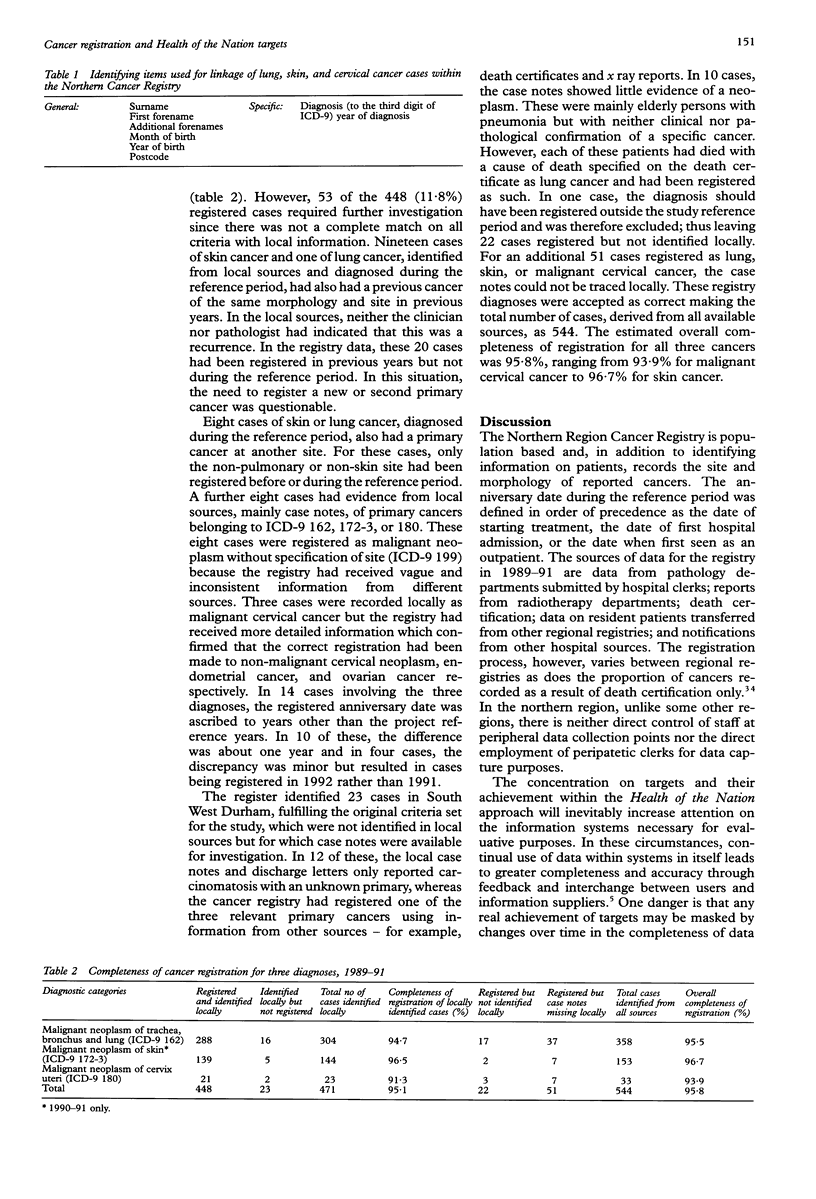Abstract
OBJECTIVE--To assess the completeness and accuracy of cancer surveillance data relevant to Health of the Nation targets. DESIGN--A comparison of locally ascertained data on cancer with recorded cancer registry sources in selected diagnoses. SETTING--The district of South West Durham within the Northern Regional Health Authority. PATIENTS--All patients with lung, skin, and malignant cervical cancer who were resident and diagnosed in the district or identified in the Northern Region Cancer Registry during the calendar period 1989-91. MAIN RESULTS--Of 544 cases of cancer identified from all available sources, 448 (95.8%) were registered, ranging from 93.9% for malignant cervical cancer to 96.7% for skin cancer. In 448 cases which were both identified locally and registered, 53 (11.8%) showed disagreements between local sources and register data, involving classification of site and timing of registration. Twenty three cases were identified locally but were not registered, 22 registered but not identified locally, and 51 registered with the casenotes missing locally. CONCLUSIONS--Any real achievement of Health of the Nation targets may be masked by changes over time in the accuracy and completeness of information systems. In assessing the achievement or otherwise of targets, it is important to be aware of any differences in the completeness and accuracy of the baseline data compared to future measurements.
Full text
PDF


Selected References
These references are in PubMed. This may not be the complete list of references from this article.
- Goldberg J., Gelfand H. M., Levy P. S. Registry evaluation methods: a review and case study. Epidemiol Rev. 1980;2:210–220. doi: 10.1093/oxfordjournals.epirev.a036224. [DOI] [PubMed] [Google Scholar]
- Lancaster G., Moran T., Woodman C. Towards achieving the Health of the Nation target for cervical cancer: accuracy of cancer registration. J Public Health Med. 1994 Mar;16(1):50–52. doi: 10.1093/oxfordjournals.pubmed.a042935. [DOI] [PubMed] [Google Scholar]
- Nwene U., Smith A. Assessing completeness of cancer registration in the north-western region of England by a method of independent comparison. Br J Cancer. 1982 Oct;46(4):635–639. doi: 10.1038/bjc.1982.248. [DOI] [PMC free article] [PubMed] [Google Scholar]
- Villard-Mackintosh L., Coleman M. P., Vessey M. P. The completeness of cancer registration in England: an assessment from the Oxford-FPA contraceptive study. Br J Cancer. 1988 Oct;58(4):507–511. doi: 10.1038/bjc.1988.252. [DOI] [PMC free article] [PubMed] [Google Scholar]
- Wilson S., Prior P., Woodman C. B. Use of cancer surveillance data for comparative analyses. J Public Health Med. 1992 Jun;14(2):151–156. [PubMed] [Google Scholar]
- Yates J. M., Davidge M. G. Can you measure performance? Br Med J (Clin Res Ed) 1984 Jun 23;288(6434):1935–1936. doi: 10.1136/bmj.288.6434.1935. [DOI] [PMC free article] [PubMed] [Google Scholar]


